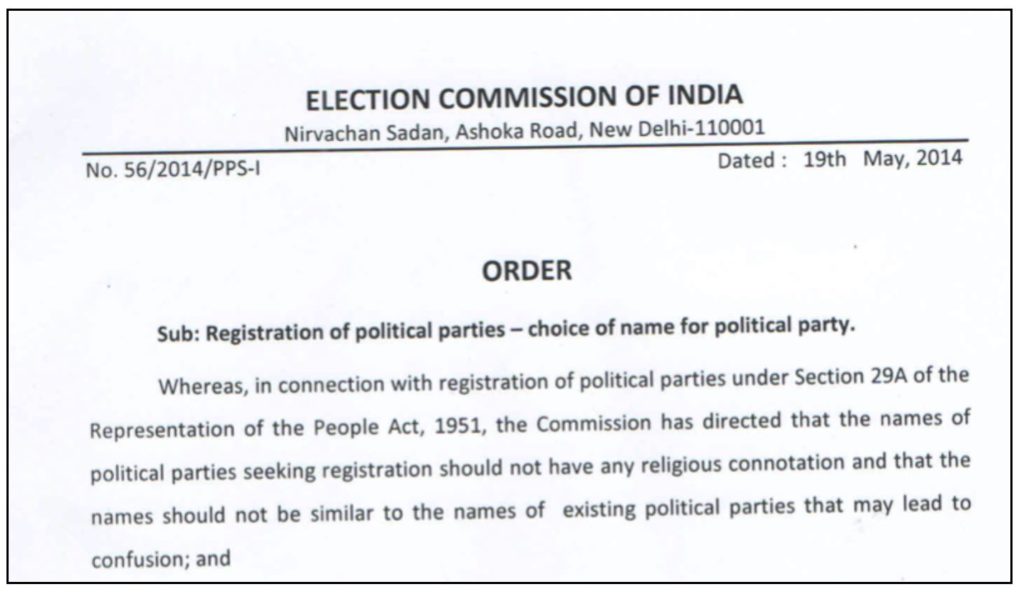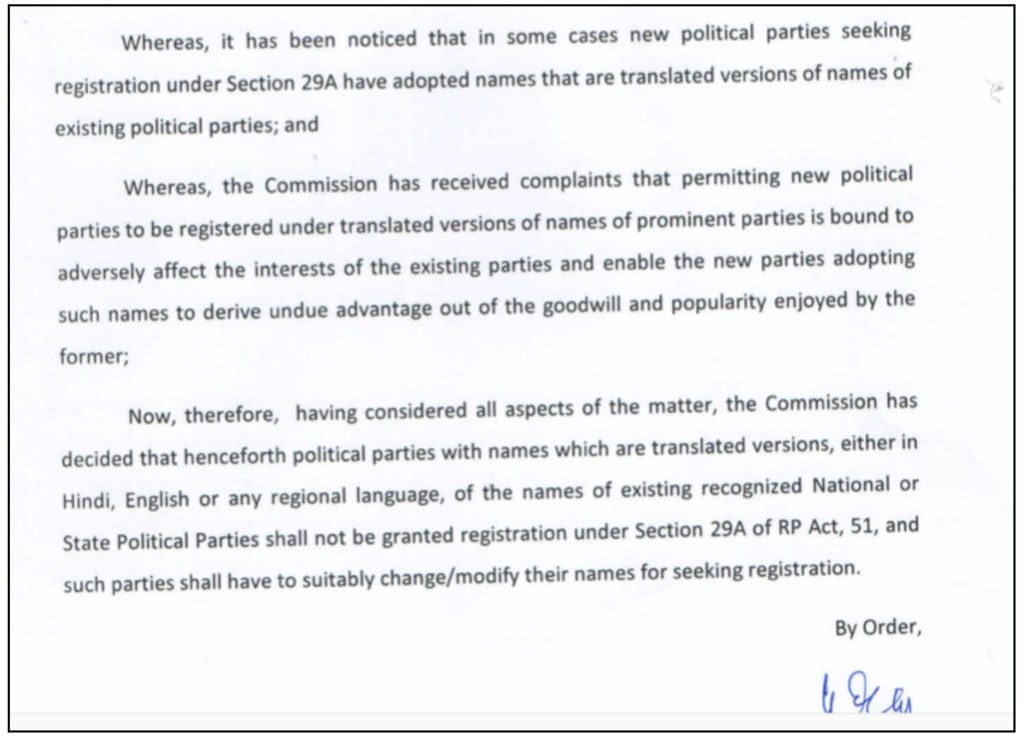There is very much in a name, especially if it is a political party. Names define & bring instant recall value to political parties. But what does the data tell us about the evolution of words used in the name of the political party in India over the last 7 decades? Which words are on the rise and which ones are disappearing?
The phrase ‘What’s in a name’ is used often to highlight the arbitrary nature of a name. But it does not hold true when the names of the political parties are being discussed, especially in India. A political party’s name represents the purpose and the idea of those who are associated with the party and helps to communicate these values to others.
Along with the party symbol, the name of the party is critical in recognition and establishing the connect with the electorate. Hence Political parties lay a lot of emphasis on the name of the party. Recognizing the importance attached to the name and the impact it could have, the Election Commission of India (ECI) has set certain rules for naming convention.
But what are the words preferred by political parties in India? We answer this question by looking at the names of all the political parties that contested the Lok Sabha elections in India from 1951 to 2019.
ECI bars political parties from having caste & religion in the name
Section 29A of Representation of People Act, 1951 requires all the political parties to be registered with ECI. Providing Name of the Political Party is a mandatory requirement. As per the amended guidelines provided by ECI for Party registration, it is categorically specified that the Name of the Party should not have any religious, caste or communal reference.
The rules for naming convention also stress upon, the name being clearly different from the name of any of the existing parties .

This differentiation for the name has been earlier made clear in an earlier order of the ECI dated 25 May 2014.

The ECI’s order further takes cognizance of a practice where in a translated version of the existing names are being used to register a new party. It was recognized that this practice can provide an undue advantage to the new parties and can have an adverse effect on the existing ones. Hence, ECI has decided that any new name of the political party cannot be a translation of the name of any existing recognized National/State political party in any language – English, Hindi or regional languages.

To sum up, the names of the political parties:
- Should not contain religious, communal or caste connotations.
- Should be different from the name of any existing recognized political party.
- Should not be a translation in any language of an existing recognized political party.
The ECI being so specific about the naming convention of a political party highlights the importance of the name and also the extent to which political parties go to gain political advantage through the name.
But what are the names that Indian Political parties feel would have more resonance with public? Do the names over the years point to any shift in ideology? Do the names reflect any trends and preference during a specific period?
We did an analysis on the Names of the Political parties, taking into consideration all the political parties, including the National & State parties which have contested in the Lok Sabha elections from 1951 to the latest i.e. 2019. The data for this analysis is collated from the statistical reports of the Lok Sabha elections available on the ECI website.

‘Bharatiya’ & ‘India’ the most used words in naming political parties
The mostly frequently used words in naming a political party have a national connotation to them.
- The word ‘Bharatiya’ or its various forms were used around 250 times in the name of a political party which contested Lok Sabha elections since 1951. Other related terms ‘Bharat’ or ‘Bharathi’ appear in the names of political party around 60 times.
- Similarly, the term ‘India’ appears around 160 times with corresponding term ‘Indian’ appearing around 50 times.
- Signifying the national trend in the names of political parties is the appearance of the term ‘Rashtriya’ around 160 times and ‘National’ appearing in the names around 60 times.
- Terms signifying universality like ‘Akhil’ appear nearly 80 times in the names.
- The significance of people in naming political parties is also visible with the presence of terms like ‘Jan’, ‘Janata’ and ‘People’ with their presence being found 80, 70 and 70 times respectively. ‘Praja’ is also used around 30 times.
- Political parties have alluded to the term ‘Democratic’ nearly 65 times with terms close to its vernacular name ‘Loktantrik’ being used around 25 times. ‘Jantantra’ is also used around 10 times. Ideas of ‘Republic’ and ‘Socialist’ are being used around 45 times each in the name. ‘Samajwadi’ the Hindi term for ‘Socialism’ is used around 30 times in the names.
- ‘Bahujan’ is used 45 times and ‘Dalit’ around 10 times. Meanwhile, the name ‘Ambedkar’ is used significantly more times than any other national figure with the name being used nearly 25 times.
- Farmers find a voice in the names of few of the political parties, with the terms ‘Kisan’ and ‘Peasant’ used around 45 times with majority being the Hindi iteration.
- ‘Communist’ is found 23 times, with terms like ‘Kranti’, ‘Revolution’ and ‘Labour’ being used around 25, 15 and 20 times respectively. Iterations of ‘Marxist’ are found around 25 times.
The national connotation in political party names is more pronounced in the last three decades
The number of political parties contesting the Lok Sabha elections has significantly increased since the 1990s. Hence there is a general increase in the number of times a word is being used in naming of the party during the past three decades compared to that of the early decades after independence.
- Among the parties which contested in the Lok Sabha elections during the 1950s (1951 & 1957), the word ‘India’ has been used more frequently followed by ‘Socialist’, ‘Praja’, ‘Bhartiya’, ‘Kisan’ etc. Apart from these were a spate of other names which had a regional and specific character to them, signifying the participation of groups during the first two elections.
- These numbers have consolidated in the next decade i.e. in the next two elections of 1962 & 1967.
- During the 1970s, there has been a comparable increase in the number of parties using ‘India’ in the name, with the term being used around 28 times.
- Meanwhile ‘Socialist’ retains its position as the next frequently used word. Over the next few decades, although there is an increase in the number of times this term is used, the increase is less pronounced compared to few other words. Relatively equal numbers are for ‘Samajwadi’, a Hindi translation of Socialism.
- The term ‘Kisan’ was sparsely used until end of 1980s, with an increase but lower compared to other words in ensuing decades. Same is the case with ‘Revolutionary’.
- ‘Bahujan’ as a term makes it entry only in 1980s in the name of a political party, signifying the formation of political parties whose goal was ensuring increased political representation of Dalits. The most successful of them, the Bahujan Samaj Party (BSP) was founded in 1984. In the ensuing decades, various parties have used the term. Even the related words like ‘Dalit’, ‘Adijan’ etc. are only found in late 1990s or in 21st century. This is a direct result of the marginalized communities asserting themselves in the political arena.
- While the number of parties have increased post 1990s, it also correlates with increase in the usage of terms like ‘India’, ‘National’, ‘Rashtriya’ etc. In fact, ‘Rashtriya’, makes is appearance only in the 1990s and is now among the most used words for the name of a political party.
- Increased numbers in the 1990s can be attributed to multiple elections (four Lok Sabha elections in 1991, 1996, 1998 & 1999) and the political instability in the country during that decade.
- The term ‘Jan’ has also found mention among naming of political parties with a considerable increase in the last decade.
- While not higher in terms of numbers when looked at individually, the last three decades has seen an increase in the usage of words in the party names that belong to specific regions. This is because of the increase in the number of regional state parties.
- There is also a relative decline in the number of parties that use the word variations related to the communists like ‘Communist’, ‘Marxist’ etc. in the last few decades. This coincides with the decline of communist parties in the electoral arena.
There is an overall dichotomy that can be observed in the naming trends. While there is an increase in the number of parties using the words with a national attribute, there is also a corresponding increase in the numbers for words which are more specifically attributed to a specific community, social group or geographical region.
Featured Image: Name of a Political Party


